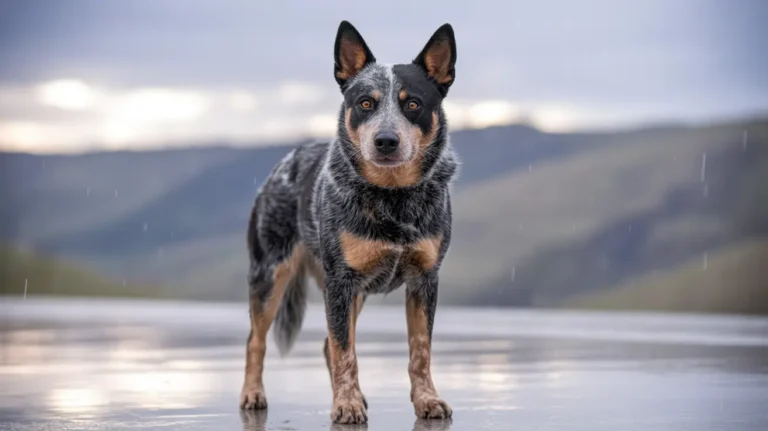Australian Shepherd Origin: Global Herding Roots
Despite its name, the Australian Shepherd is not from Australia. Its history is linked to Europe, Australia, and the United States. Many assume it was developed in Australia, but its true origins reveal an interesting background.
The breed developed in America, where ranchers refined their skills for herding and farm work. The name likely comes from Australian sheep and shepherds who played a small role in its early history.
The Australian Shepherd is a highly intelligent and energetic breed. It is known for its versatility in herding and dog sports and as a loyal companion. These dogs are popular for their trainability and agility.
Australian shepherd Origin: The Early Ancestors
The Australian Shepherd origin is filled with influences from different regions. Though its name suggests an Australian origin, the breed’s journey began long before it reached America. Its ancestry is linked to Spanish herding dogs and Basque shepherds.
Spanish Ancestry
In the 1500s, Spanish settlers brought Churra sheep to the Americas. These sheep were highly valued for their meat and wool. To manage them, the Spanish brought strong and intelligent herding dogs that could work in tough conditions.
One of these dogs was the Carea Leonés, a breed known for its sharp instincts, merle coats, and sometimes blue eyes. Many believe this breed influenced the appearance and working ability of the modern Australian Shepherd.
Basque Influence
The Basque shepherds from the Pyrenees region between Spain and France were famous for their hardworking sheepdogs. In search of better opportunities, many of them migrated to Australia in the 19th century, bringing their dogs with them.
Some experts believe that the Basque Shepherd Dog contributed to the development of early Australian Shepherds. These dogs were highly intelligent and adaptable, making them excellent herders across different landscapes.
Australia’s Role in Developing Herding Dogs
As sheep farming expanded, Australian farmers needed strong, intelligent dogs to manage large flocks. The arrival of Merino sheep made herding even harder. This increased the demand for skilled working dogs.
Merino Sheep: A New Herding Challenge
In the late 1700s, Merino sheep arrived in Australia from Spain. These sheep were prized for their fine wool but were hard to control. Farmers needed fast, smart dogs to handle them.
British Herding Dogs: The Perfect Workers
To solve this, British settlers brought Collies and Border Collies. These dogs were quick learners and excellent herders. But Australia’s rough climate was tough on them. Over time, they adapted, becoming stronger, faster, and more resilient.
Their improved herding skills and hardworking nature later became key traits of the Australian Shepherd’s ancestors.
Genetic Insights: Understanding the Australian Shepherd’s Heritage
The Australian Shepherd shares its genetic roots with British herding breeds. These dogs shaped their working abilities and physical traits over time.
Studies classify it within the UK Rural clade, a genetic group that includes breeds like the Collie and Border Collie. This connection highlights their shared ancestry and strong herding instincts.
Like other Collie-type breeds, Australian Shepherds carry specific genetic traits. One is the MDR1 mutation, which makes them sensitive to certain drugs.
Another is Collie Eye Anomaly (CEA), a hereditary eye condition. These genetic markers confirm the Australian Shepherd’s deep connection to British herding dogs, despite its development in the United States.
From Australia to America: A New Beginning
By the mid-1800s, Australian sheep and herding dogs were exported to America to support the wool industry. These dogs quickly gained recognition for their herding skills and adaptability.
The Gold Rush and the Arrival of Herding Dogs
During the California Gold Rush (1848–1855), the demand for wool increased in the U.S. Australian ranchers shipped Merino sheep to America, along with their trusted herding dogs. These dogs proved to be hardworking, intelligent, and skilled at managing livestock.
The ‘Little Blue Dogs’ Stand Out
American ranchers were impressed by these merle-coated herding dogs. Their sharp instincts, agility, and endurance made them ideal for large farms and ranches. Many called them “Little Blue Dogs” due to their distinctive blue merle coats.
How They Got Their Name
Although these dogs were refined in America, they were linked to Australia because they arrived with Australian sheep and shepherds. This connection likely led to the name “Australian Shepherd.”
Establishing the Breed in the United States
After arriving in America, these herding dogs became highly valued by ranchers. Over time, they were refined into the Australian Shepherd we know today.
Ranchers’ Role in Shaping the Breed
American ranchers and farmers admired these dogs for their intelligence, agility, and strong work ethic. They selectively bred them to enhance their herding instincts, endurance, and adaptability. This helped shape the modern Australian Shepherd into a versatile working dog.
Formal Recognition
As the breed gained popularity, dedicated breeders worked to preserve its traits. This led to the formation of the Australian Shepherd Club of America (ASCA) in 1957, which established the first official breed standards.
Later, the breed was recognized by major kennel clubs:
These recognitions cemented the Australian Shepherd’s place as a distinct and respected breed in the United States and beyond.
Modern Role and Popularity
The Australian Shepherd has evolved from a working farm dog to a breed with many roles. While they are still excellent herding dogs, their intelligence and agility make them perfect for search and rescue, therapy work, and dog sports. Their loyalty and energy also make them wonderful family companions, especially for active households.
Today, the Australian Shepherd is one of the most popular dog breeds in North America. It consistently ranks among the top breeds in kennel club registrations, proving its enduring appeal.
Conclusion
The Australian Shepherd’s history is a story of global influence. From Spanish herding dogs to Basque shepherds and finally American ranchers, many cultures played a role in shaping this breed.
Despite its misleading name, the Australian Shepherd is a true working dog with remarkable intelligence and versatility. Over time, it has adapted to various roles, excelling in herding, service work, and as a loving family companion.
With its loyal nature, boundless energy, and adaptability, the Australian Shepherd continues to be a beloved and respected breed worldwide.






